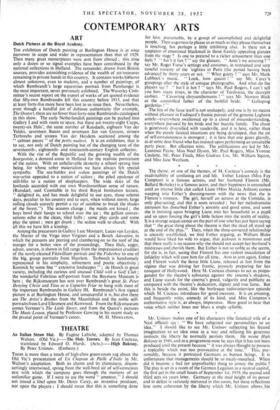CONTEMPORARY ARTS
ART
Dutch Pictures at the Royal Academy.
Tim exhibition of Dutch painting at Burlington House is at once narrower in scope and wider in representation than that of 1929. Then many great masterpieces were sent from abroad ; this time only a dozen or so signal examples have been contributed by the national collections in Holland. The remainder, drawn from British sources, provides astonishing evidence of the wealth of art-treasures remaining in private hands in this country. It contains works hitherto almost unknown, even to students, and a number of paintings, of which Rembrandt's large equestrian portrait from Panshanger is the most important, never previously exhibited. The Waverley Com- mittee's recent report on the export of works of art quoted evidence that fifty-two Rembrandts left this country before 1913, and that at least forty-five more have been lost to us since then. Nevertheless, even though a handful are of dubious authenticity (for example, The Orator), there are no fewer than forty-nine Rembrandts catalogued in this show. The early Netherlandish paintings can be packed into Gallery I and with room to spare, but there are twenty-eight Cuyps, twenty-six Hals', the same number of Ruisdaels, eighteen Van der Veldes, seventeen Steens and seventeen Jan van Goyens, sixteen Terborchs and sixteen Van der Heydens scattered among the "cabinet pieces " of the petits maitres. It is an exhibition, that is to say, not only of Dutch painting but of the changing taste of the seventeenth-, eighteenth- and nineteenth-century English collector.
With the rise of the Republic and the growing wealth of the bourgeoisie, a demand arose in Holland for the realistic portraiture of the nation. With an unbelievable dexterity a school sprang into being, for whose sober materialism we have always felt special sympathy. The sea-battles and reduta paintings of the Dutch war-artist appealed to a nation of sailors ; the piled opulence of still-lifes to a nation of shopkeepers. The wide skies of the lowlands accorded with our own Wordsworthian sense of nature. (Ruisdael, said Constable in his third Royal Institution lecture, "delighted in, and has made delightful to our eyes, those solemn days, peculiar to his country and to ours, when without storm, large rolling clouds scarcely permit a ray of sunshine to break the shades of the forest.") The seasons change ; the maids are kissed ; the boys bowl their hoops to school over the ice ; the gallant conver- sations echo in the clean, tiled halls ; some play cards and some play the spinet ; men get drunk ; the sedate walk to church. With all this we have felt a kinship.
Among the precursors in Gallery I are Mostaert, Lucas van Leyden, the Master of the Virgo inter Virgines and 'a Bosch Adoration, in which the peasants are peering and clambering on to the roof of the manger for a better view of the proceedings. Then Hals, eager, adroit, uneven, is shown in full range from the impressionist crudities of the newly-cleaned Fitzwilliam portrait and the Fisherboy to one of the big, group portraits from Haarlem. Terborch is handsomely represented in his simplicity, refinement and poetic objectivity ; Koninck by some fine " extensive landscapes " ; de Hooch in great variety, including the curious and unusual Child with a Golf Club ; the wonderful Fabritius self-portrait from the Boymans Museum is here ; the Rijksmuseum has sent over Rembrandt's great St. Peter Denying Christ and Titus as a Capuchin Friar to hang with most of the important Rembrandts in Gallery III. Rembrandt's first signed picture is at Burlington House, and unsuccessful it is, but also there are The Artist's Brother from the Mauritshuis and the noble self- portraits from Lord Ellesmere and Kenwood. From the Rijksmuseum comes Vermeer 's The Little Street, and from the Queen's pictures The Music Lesson, placed by Professor Gowing in his recent study as the pivotal point of Vermeer's career. M. H. MIDDLETON.


































 Previous page
Previous page